Business Environment: Micro, Macro Factors and Ethical Management
VerifiedAdded on 2021/01/03
|7
|1566
|32
Report
AI Summary
This report provides a comprehensive analysis of the business environment, focusing on both micro and macro environmental factors. The micro-environmental factors discussed include competitors, customers, suppliers and distribution channels, and workers/employees. The macro-environmental factors examined include economic, demographic, political, technological, natural, and social factors. The report further explores the need for individuals and organizations to manage responsibly, sustainably, and ethically in relation to social, cultural, economic, and environmental issues. It outlines the roles of both individuals and organizations in addressing these issues, emphasizing the importance of ethical conduct and sustainable practices. The report concludes by summarizing the key findings and highlighting the interconnectedness of these factors in shaping modern business practices.
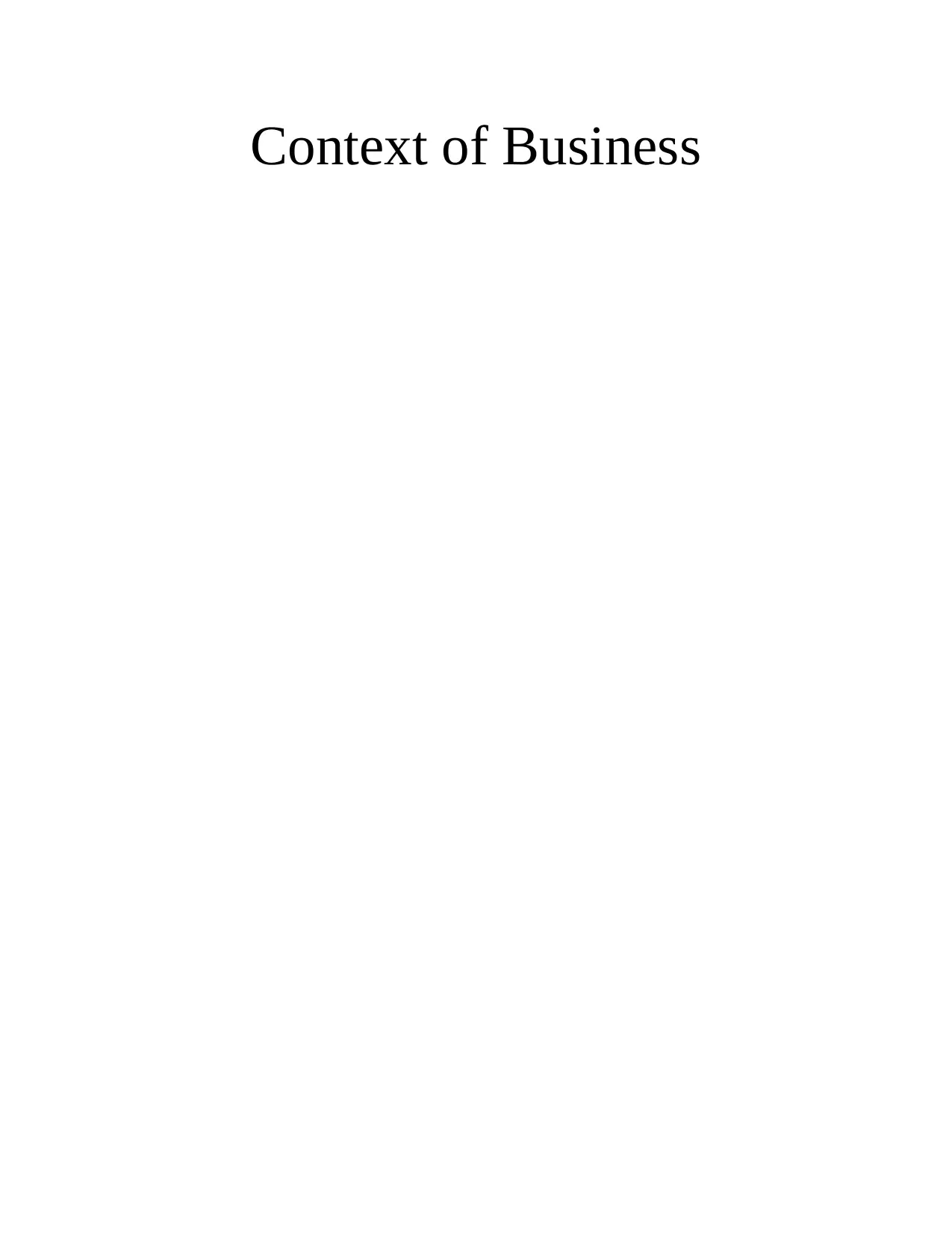
Context of Business
Paraphrase This Document
Need a fresh take? Get an instant paraphrase of this document with our AI Paraphraser
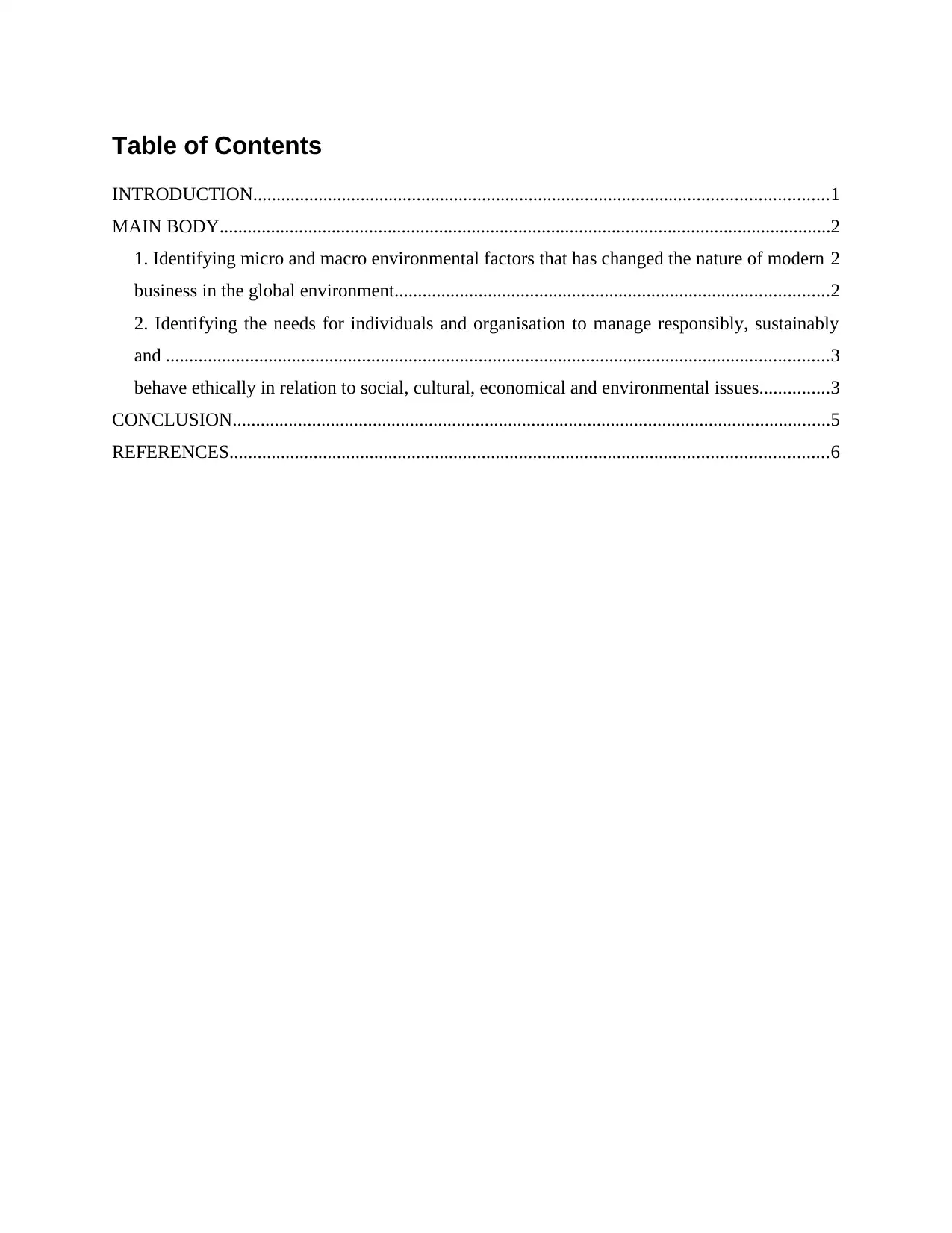
Table of Contents
INTRODUCTION...........................................................................................................................1
MAIN BODY...................................................................................................................................2
1. Identifying micro and macro environmental factors that has changed the nature of modern 2
business in the global environment.............................................................................................2
2. Identifying the needs for individuals and organisation to manage responsibly, sustainably
and ..............................................................................................................................................3
behave ethically in relation to social, cultural, economical and environmental issues...............3
CONCLUSION................................................................................................................................5
REFERENCES................................................................................................................................6
INTRODUCTION...........................................................................................................................1
MAIN BODY...................................................................................................................................2
1. Identifying micro and macro environmental factors that has changed the nature of modern 2
business in the global environment.............................................................................................2
2. Identifying the needs for individuals and organisation to manage responsibly, sustainably
and ..............................................................................................................................................3
behave ethically in relation to social, cultural, economical and environmental issues...............3
CONCLUSION................................................................................................................................5
REFERENCES................................................................................................................................6
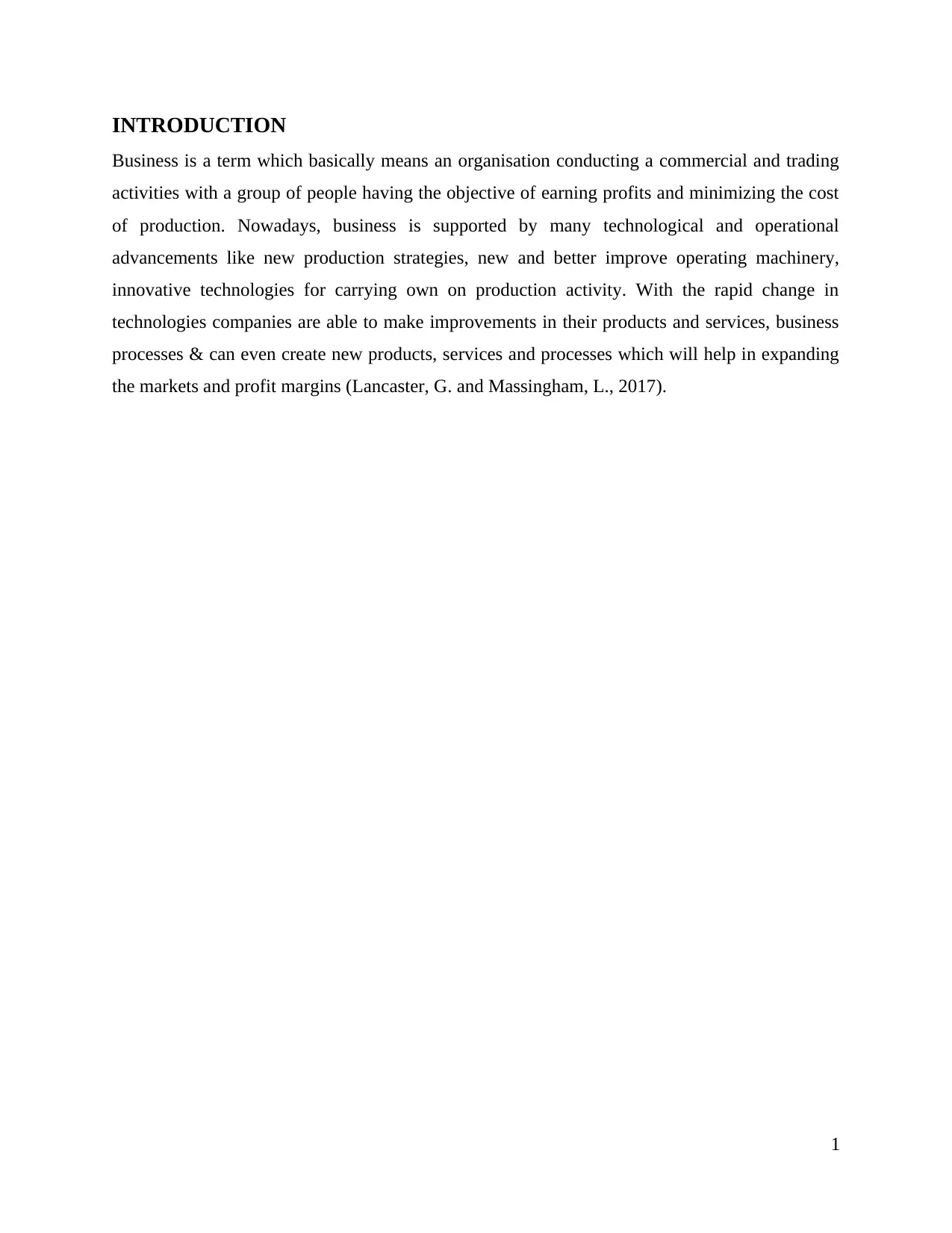
INTRODUCTION
Business is a term which basically means an organisation conducting a commercial and trading
activities with a group of people having the objective of earning profits and minimizing the cost
of production. Nowadays, business is supported by many technological and operational
advancements like new production strategies, new and better improve operating machinery,
innovative technologies for carrying own on production activity. With the rapid change in
technologies companies are able to make improvements in their products and services, business
processes & can even create new products, services and processes which will help in expanding
the markets and profit margins (Lancaster, G. and Massingham, L., 2017).
1
Business is a term which basically means an organisation conducting a commercial and trading
activities with a group of people having the objective of earning profits and minimizing the cost
of production. Nowadays, business is supported by many technological and operational
advancements like new production strategies, new and better improve operating machinery,
innovative technologies for carrying own on production activity. With the rapid change in
technologies companies are able to make improvements in their products and services, business
processes & can even create new products, services and processes which will help in expanding
the markets and profit margins (Lancaster, G. and Massingham, L., 2017).
1
⊘ This is a preview!⊘
Do you want full access?
Subscribe today to unlock all pages.

Trusted by 1+ million students worldwide
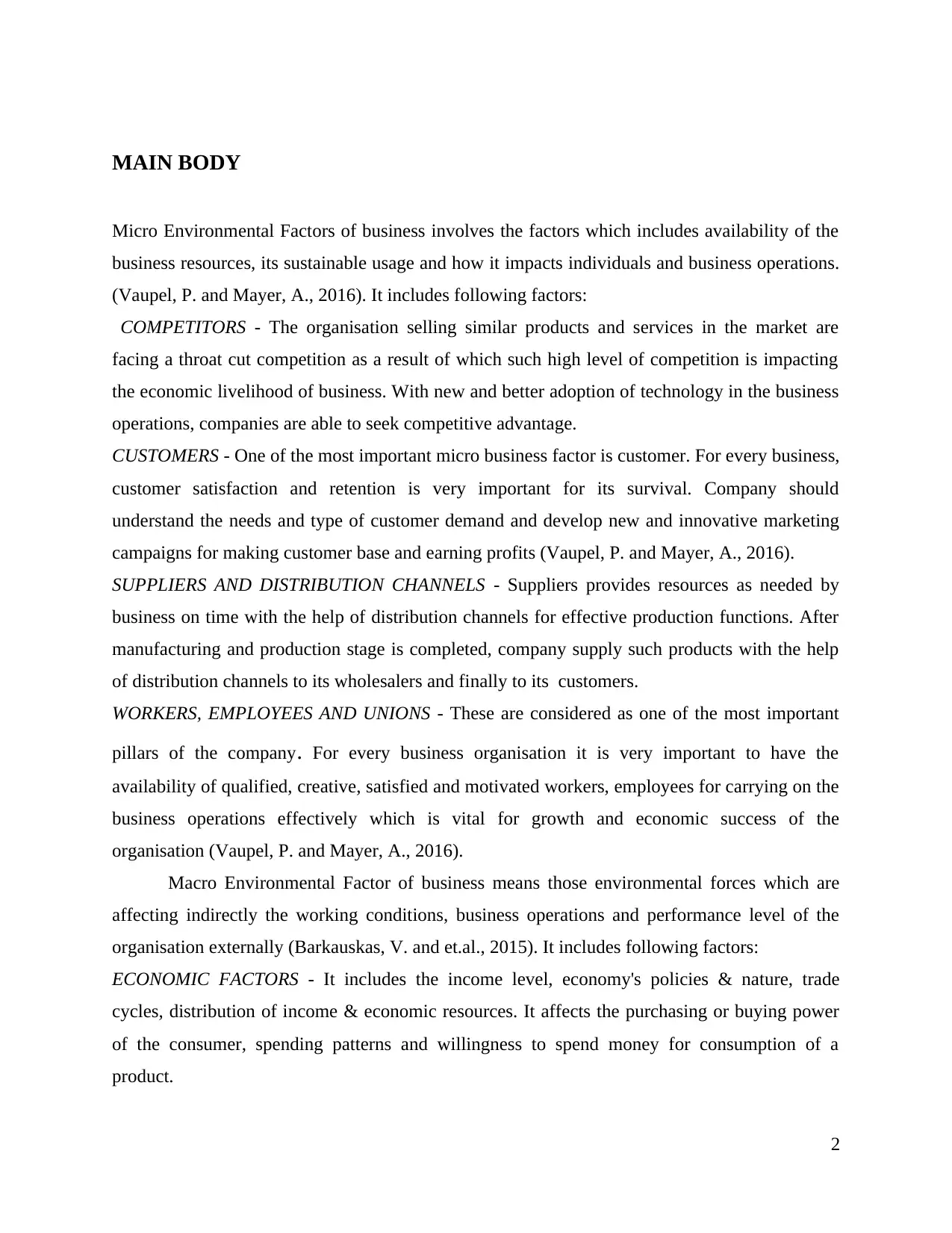
MAIN BODY
Micro Environmental Factors of business involves the factors which includes availability of the
business resources, its sustainable usage and how it impacts individuals and business operations.
(Vaupel, P. and Mayer, A., 2016). It includes following factors:
COMPETITORS - The organisation selling similar products and services in the market are
facing a throat cut competition as a result of which such high level of competition is impacting
the economic livelihood of business. With new and better adoption of technology in the business
operations, companies are able to seek competitive advantage.
CUSTOMERS - One of the most important micro business factor is customer. For every business,
customer satisfaction and retention is very important for its survival. Company should
understand the needs and type of customer demand and develop new and innovative marketing
campaigns for making customer base and earning profits (Vaupel, P. and Mayer, A., 2016).
SUPPLIERS AND DISTRIBUTION CHANNELS - Suppliers provides resources as needed by
business on time with the help of distribution channels for effective production functions. After
manufacturing and production stage is completed, company supply such products with the help
of distribution channels to its wholesalers and finally to its customers.
WORKERS, EMPLOYEES AND UNIONS - These are considered as one of the most important
pillars of the company. For every business organisation it is very important to have the
availability of qualified, creative, satisfied and motivated workers, employees for carrying on the
business operations effectively which is vital for growth and economic success of the
organisation (Vaupel, P. and Mayer, A., 2016).
Macro Environmental Factor of business means those environmental forces which are
affecting indirectly the working conditions, business operations and performance level of the
organisation externally (Barkauskas, V. and et.al., 2015). It includes following factors:
ECONOMIC FACTORS - It includes the income level, economy's policies & nature, trade
cycles, distribution of income & economic resources. It affects the purchasing or buying power
of the consumer, spending patterns and willingness to spend money for consumption of a
product.
2
Micro Environmental Factors of business involves the factors which includes availability of the
business resources, its sustainable usage and how it impacts individuals and business operations.
(Vaupel, P. and Mayer, A., 2016). It includes following factors:
COMPETITORS - The organisation selling similar products and services in the market are
facing a throat cut competition as a result of which such high level of competition is impacting
the economic livelihood of business. With new and better adoption of technology in the business
operations, companies are able to seek competitive advantage.
CUSTOMERS - One of the most important micro business factor is customer. For every business,
customer satisfaction and retention is very important for its survival. Company should
understand the needs and type of customer demand and develop new and innovative marketing
campaigns for making customer base and earning profits (Vaupel, P. and Mayer, A., 2016).
SUPPLIERS AND DISTRIBUTION CHANNELS - Suppliers provides resources as needed by
business on time with the help of distribution channels for effective production functions. After
manufacturing and production stage is completed, company supply such products with the help
of distribution channels to its wholesalers and finally to its customers.
WORKERS, EMPLOYEES AND UNIONS - These are considered as one of the most important
pillars of the company. For every business organisation it is very important to have the
availability of qualified, creative, satisfied and motivated workers, employees for carrying on the
business operations effectively which is vital for growth and economic success of the
organisation (Vaupel, P. and Mayer, A., 2016).
Macro Environmental Factor of business means those environmental forces which are
affecting indirectly the working conditions, business operations and performance level of the
organisation externally (Barkauskas, V. and et.al., 2015). It includes following factors:
ECONOMIC FACTORS - It includes the income level, economy's policies & nature, trade
cycles, distribution of income & economic resources. It affects the purchasing or buying power
of the consumer, spending patterns and willingness to spend money for consumption of a
product.
2
Paraphrase This Document
Need a fresh take? Get an instant paraphrase of this document with our AI Paraphraser
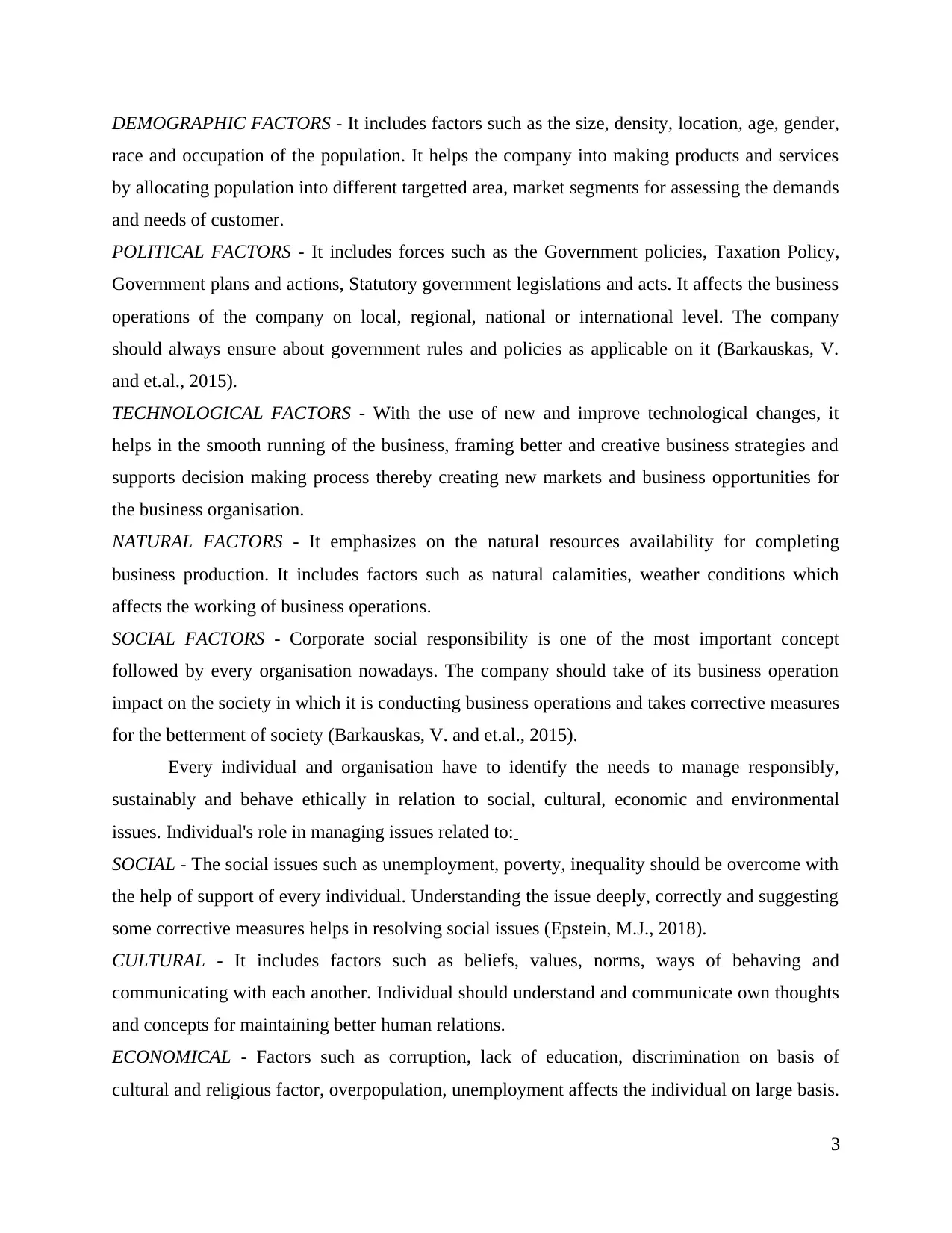
DEMOGRAPHIC FACTORS - It includes factors such as the size, density, location, age, gender,
race and occupation of the population. It helps the company into making products and services
by allocating population into different targetted area, market segments for assessing the demands
and needs of customer.
POLITICAL FACTORS - It includes forces such as the Government policies, Taxation Policy,
Government plans and actions, Statutory government legislations and acts. It affects the business
operations of the company on local, regional, national or international level. The company
should always ensure about government rules and policies as applicable on it (Barkauskas, V.
and et.al., 2015).
TECHNOLOGICAL FACTORS - With the use of new and improve technological changes, it
helps in the smooth running of the business, framing better and creative business strategies and
supports decision making process thereby creating new markets and business opportunities for
the business organisation.
NATURAL FACTORS - It emphasizes on the natural resources availability for completing
business production. It includes factors such as natural calamities, weather conditions which
affects the working of business operations.
SOCIAL FACTORS - Corporate social responsibility is one of the most important concept
followed by every organisation nowadays. The company should take of its business operation
impact on the society in which it is conducting business operations and takes corrective measures
for the betterment of society (Barkauskas, V. and et.al., 2015).
Every individual and organisation have to identify the needs to manage responsibly,
sustainably and behave ethically in relation to social, cultural, economic and environmental
issues. Individual's role in managing issues related to:
SOCIAL - The social issues such as unemployment, poverty, inequality should be overcome with
the help of support of every individual. Understanding the issue deeply, correctly and suggesting
some corrective measures helps in resolving social issues (Epstein, M.J., 2018).
CULTURAL - It includes factors such as beliefs, values, norms, ways of behaving and
communicating with each another. Individual should understand and communicate own thoughts
and concepts for maintaining better human relations.
ECONOMICAL - Factors such as corruption, lack of education, discrimination on basis of
cultural and religious factor, overpopulation, unemployment affects the individual on large basis.
3
race and occupation of the population. It helps the company into making products and services
by allocating population into different targetted area, market segments for assessing the demands
and needs of customer.
POLITICAL FACTORS - It includes forces such as the Government policies, Taxation Policy,
Government plans and actions, Statutory government legislations and acts. It affects the business
operations of the company on local, regional, national or international level. The company
should always ensure about government rules and policies as applicable on it (Barkauskas, V.
and et.al., 2015).
TECHNOLOGICAL FACTORS - With the use of new and improve technological changes, it
helps in the smooth running of the business, framing better and creative business strategies and
supports decision making process thereby creating new markets and business opportunities for
the business organisation.
NATURAL FACTORS - It emphasizes on the natural resources availability for completing
business production. It includes factors such as natural calamities, weather conditions which
affects the working of business operations.
SOCIAL FACTORS - Corporate social responsibility is one of the most important concept
followed by every organisation nowadays. The company should take of its business operation
impact on the society in which it is conducting business operations and takes corrective measures
for the betterment of society (Barkauskas, V. and et.al., 2015).
Every individual and organisation have to identify the needs to manage responsibly,
sustainably and behave ethically in relation to social, cultural, economic and environmental
issues. Individual's role in managing issues related to:
SOCIAL - The social issues such as unemployment, poverty, inequality should be overcome with
the help of support of every individual. Understanding the issue deeply, correctly and suggesting
some corrective measures helps in resolving social issues (Epstein, M.J., 2018).
CULTURAL - It includes factors such as beliefs, values, norms, ways of behaving and
communicating with each another. Individual should understand and communicate own thoughts
and concepts for maintaining better human relations.
ECONOMICAL - Factors such as corruption, lack of education, discrimination on basis of
cultural and religious factor, overpopulation, unemployment affects the individual on large basis.
3
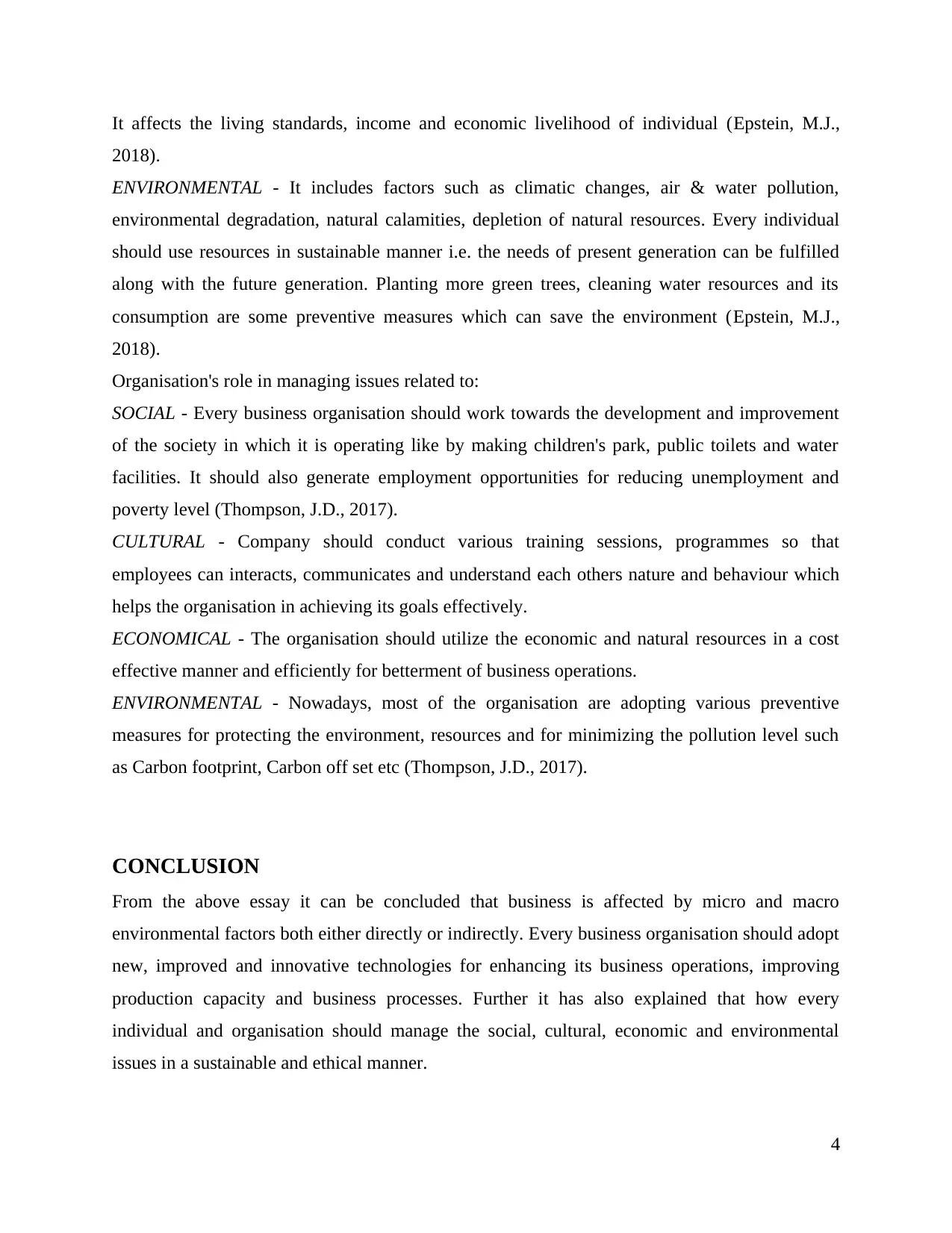
It affects the living standards, income and economic livelihood of individual (Epstein, M.J.,
2018).
ENVIRONMENTAL - It includes factors such as climatic changes, air & water pollution,
environmental degradation, natural calamities, depletion of natural resources. Every individual
should use resources in sustainable manner i.e. the needs of present generation can be fulfilled
along with the future generation. Planting more green trees, cleaning water resources and its
consumption are some preventive measures which can save the environment (Epstein, M.J.,
2018).
Organisation's role in managing issues related to:
SOCIAL - Every business organisation should work towards the development and improvement
of the society in which it is operating like by making children's park, public toilets and water
facilities. It should also generate employment opportunities for reducing unemployment and
poverty level (Thompson, J.D., 2017).
CULTURAL - Company should conduct various training sessions, programmes so that
employees can interacts, communicates and understand each others nature and behaviour which
helps the organisation in achieving its goals effectively.
ECONOMICAL - The organisation should utilize the economic and natural resources in a cost
effective manner and efficiently for betterment of business operations.
ENVIRONMENTAL - Nowadays, most of the organisation are adopting various preventive
measures for protecting the environment, resources and for minimizing the pollution level such
as Carbon footprint, Carbon off set etc (Thompson, J.D., 2017).
CONCLUSION
From the above essay it can be concluded that business is affected by micro and macro
environmental factors both either directly or indirectly. Every business organisation should adopt
new, improved and innovative technologies for enhancing its business operations, improving
production capacity and business processes. Further it has also explained that how every
individual and organisation should manage the social, cultural, economic and environmental
issues in a sustainable and ethical manner.
4
2018).
ENVIRONMENTAL - It includes factors such as climatic changes, air & water pollution,
environmental degradation, natural calamities, depletion of natural resources. Every individual
should use resources in sustainable manner i.e. the needs of present generation can be fulfilled
along with the future generation. Planting more green trees, cleaning water resources and its
consumption are some preventive measures which can save the environment (Epstein, M.J.,
2018).
Organisation's role in managing issues related to:
SOCIAL - Every business organisation should work towards the development and improvement
of the society in which it is operating like by making children's park, public toilets and water
facilities. It should also generate employment opportunities for reducing unemployment and
poverty level (Thompson, J.D., 2017).
CULTURAL - Company should conduct various training sessions, programmes so that
employees can interacts, communicates and understand each others nature and behaviour which
helps the organisation in achieving its goals effectively.
ECONOMICAL - The organisation should utilize the economic and natural resources in a cost
effective manner and efficiently for betterment of business operations.
ENVIRONMENTAL - Nowadays, most of the organisation are adopting various preventive
measures for protecting the environment, resources and for minimizing the pollution level such
as Carbon footprint, Carbon off set etc (Thompson, J.D., 2017).
CONCLUSION
From the above essay it can be concluded that business is affected by micro and macro
environmental factors both either directly or indirectly. Every business organisation should adopt
new, improved and innovative technologies for enhancing its business operations, improving
production capacity and business processes. Further it has also explained that how every
individual and organisation should manage the social, cultural, economic and environmental
issues in a sustainable and ethical manner.
4
⊘ This is a preview!⊘
Do you want full access?
Subscribe today to unlock all pages.

Trusted by 1+ million students worldwide
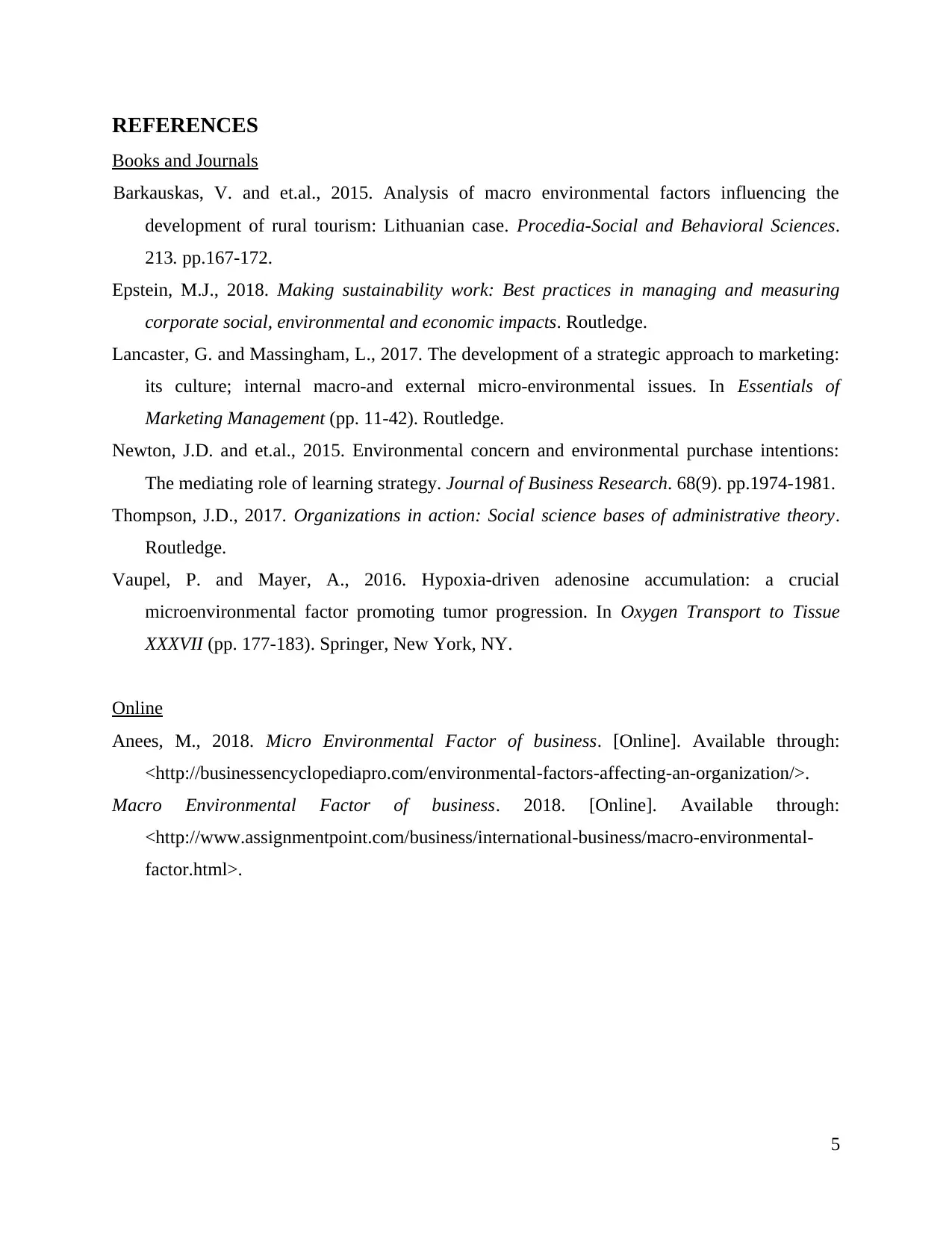
REFERENCES
Books and Journals
Barkauskas, V. and et.al., 2015. Analysis of macro environmental factors influencing the
development of rural tourism: Lithuanian case. Procedia-Social and Behavioral Sciences.
213. pp.167-172.
Epstein, M.J., 2018. Making sustainability work: Best practices in managing and measuring
corporate social, environmental and economic impacts. Routledge.
Lancaster, G. and Massingham, L., 2017. The development of a strategic approach to marketing:
its culture; internal macro-and external micro-environmental issues. In Essentials of
Marketing Management (pp. 11-42). Routledge.
Newton, J.D. and et.al., 2015. Environmental concern and environmental purchase intentions:
The mediating role of learning strategy. Journal of Business Research. 68(9). pp.1974-1981.
Thompson, J.D., 2017. Organizations in action: Social science bases of administrative theory.
Routledge.
Vaupel, P. and Mayer, A., 2016. Hypoxia-driven adenosine accumulation: a crucial
microenvironmental factor promoting tumor progression. In Oxygen Transport to Tissue
XXXVII (pp. 177-183). Springer, New York, NY.
Online
Anees, M., 2018. Micro Environmental Factor of business. [Online]. Available through:
<http://businessencyclopediapro.com/environmental-factors-affecting-an-organization/>.
Macro Environmental Factor of business. 2018. [Online]. Available through:
<http://www.assignmentpoint.com/business/international-business/macro-environmental-
factor.html>.
5
Books and Journals
Barkauskas, V. and et.al., 2015. Analysis of macro environmental factors influencing the
development of rural tourism: Lithuanian case. Procedia-Social and Behavioral Sciences.
213. pp.167-172.
Epstein, M.J., 2018. Making sustainability work: Best practices in managing and measuring
corporate social, environmental and economic impacts. Routledge.
Lancaster, G. and Massingham, L., 2017. The development of a strategic approach to marketing:
its culture; internal macro-and external micro-environmental issues. In Essentials of
Marketing Management (pp. 11-42). Routledge.
Newton, J.D. and et.al., 2015. Environmental concern and environmental purchase intentions:
The mediating role of learning strategy. Journal of Business Research. 68(9). pp.1974-1981.
Thompson, J.D., 2017. Organizations in action: Social science bases of administrative theory.
Routledge.
Vaupel, P. and Mayer, A., 2016. Hypoxia-driven adenosine accumulation: a crucial
microenvironmental factor promoting tumor progression. In Oxygen Transport to Tissue
XXXVII (pp. 177-183). Springer, New York, NY.
Online
Anees, M., 2018. Micro Environmental Factor of business. [Online]. Available through:
<http://businessencyclopediapro.com/environmental-factors-affecting-an-organization/>.
Macro Environmental Factor of business. 2018. [Online]. Available through:
<http://www.assignmentpoint.com/business/international-business/macro-environmental-
factor.html>.
5
1 out of 7
Related Documents
Your All-in-One AI-Powered Toolkit for Academic Success.
+13062052269
info@desklib.com
Available 24*7 on WhatsApp / Email
![[object Object]](/_next/static/media/star-bottom.7253800d.svg)
Unlock your academic potential
Copyright © 2020–2025 A2Z Services. All Rights Reserved. Developed and managed by ZUCOL.





